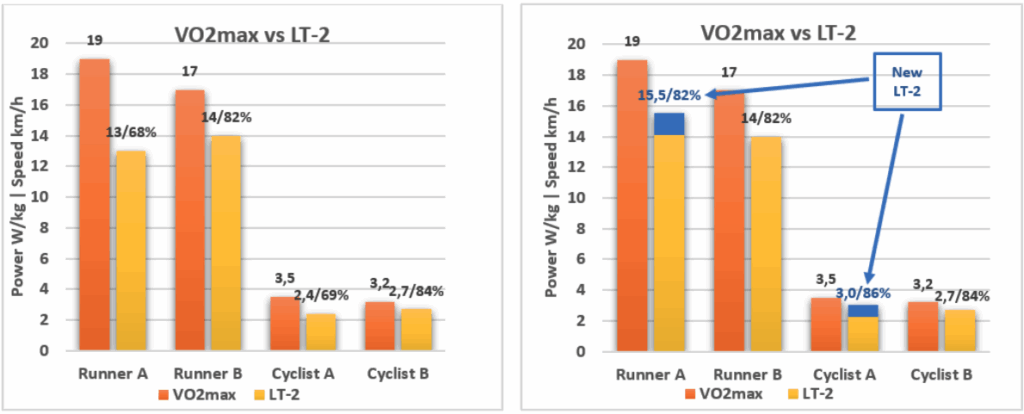Votre panier est actuellement vide !
In the world of endurance sports, the terms « lactate threshold » (LT) and « VO₂ max » come up frequently — but what do they really mean, and why should you care?
Among all the factors that influence athletic performance, LT and VO₂ max are arguably two of the most critical. Knowing your numbers helps you train smarter, and improving these two metrics can make you faster, stronger, and more resilient.
What Is Lactate Threshold?
As you exercise, your body starts producing lactate — a byproduct of glucose metabolism — to meet rising energy demands. When the effort becomes intense enough that your aerobic system can no longer keep up, lactate begins to accumulate in the bloodstream. This buildup eventually forces you to slow down.
Your lactate threshold marks the highest intensity you can sustain before this accumulation spirals out of control. Athletes can generally maintain this level for about 40 to 60 minutes. It’s typically defined by the heart rate, pace, or power output at which blood lactate concentration reaches around 4 mmol/L.
Training based on your lactate threshold lets you tailor sessions to your current fitness level. It helps you work efficiently without overreaching, reducing injury risk while enhancing endurance capacity.
What About VO₂ Max?
VO₂ max refers to the maximum amount of oxygen your body can take in, transport, and use during intense exercise — measured in milliliters per kilogram per minute (mL/kg/min). It represents your aerobic ceiling.
Efforts at VO₂ max intensity are short and highly demanding, usually lasting 6 to 10 minutes, and require near-maximal heart rates. While it’s a popular performance metric, VO₂ max is less trainable than LT and is heavily influenced by genetics and body weight.
The average untrained adult has a VO₂ max around 35 mL/kg/min, with trained runners usually in the 50–70 range. Elite endurance athletes can reach 80–90 mL/kg/min. Female athletes generally score 5–15% lower due to physiological differences.
How to Measure LT and VO₂ Max
LT can be determined through lab-based lactate testing or estimated via field tests. For example, a 40–60-minute time trial at maximum sustainable pace (approximately 10–15 km running or 30–40 km cycling for recreational athletes) can offer a reliable estimate.
VO₂ max requires lab testing with a metabolic cart for precise measurement. However, a maximal effort test lasting around 8–9 minutes can help you determine training intensities that correspond to your VO₂ max heart rate, pace, or power.
Which Is More Important?
To illustrate, imagine two runners. Runner A has a VO₂ max speed of 19 km/h but a lactate threshold of 13 km/h — 68% of their VO₂ max. Runner B has a lower VO₂ max of 17 km/h but a higher LT of 14 km/h — 82% of VO₂ max. A similar scenario applies to two cyclists with comparable stats.

In short races, Runner A may perform better thanks to a higher aerobic ceiling. However, in longer events, Runner B is likely to outperform due to the ability to sustain a higher percentage of their VO₂ max.
Now imagine Runner A and Cyclist A work specifically to improve their LT. Their performance would likely improve in both short and long events, highlighting the value of training LT — which is much more responsive to training than VO₂ max.
Boosting VO₂ Max
Though largely genetic, VO₂ max can be developed with targeted training. These workouts should only be introduced once you’ve established a solid aerobic base and good muscular resilience.
Workouts designed to target VO₂ max typically include 1–5-minute intervals at high intensity, interspersed with active recovery lasting 50–100% of the work interval duration. Total VO₂ max time during the session should fall between 10 and 20 minutes.
Running examples
- Short intervals: 10–12 x 400 meters, with equal-time active recovery
- Longer intervals: 4–5 x 1200 meters, with 2.5–3.5 minutes of active recovery
Cycling examples
- Short intervals: 8–12 x 1.5-minute uphill efforts, with downhill recovery of equal duration
- Longer intervals: 4–5 x 4-minute flat intervals, with 3–4 minutes of recovery at 50% of LT effort
Plan for 36–48 hours of recovery after VO₂ max sessions due to their taxing nature.
Developing Your Lactate Threshold
LT-focused workouts are slightly less intense but longer in duration. A typical session involves 30–60 minutes of total work, split into intervals of 4–12 minutes with brief active recoveries (1–3 minutes), following a 1:3 or 1:5 work-to-rest ratio.
Running examples
- Shorter intervals: 6–10 x 1 km, with 1–1.5 minutes of recovery
- Longer intervals: 3–4 x 3 km, with 3-minute jog recoveries
Cycling examples
- Shorter intervals: 8–10 x 4 minutes, with 1 minute of easy riding between sets
- Longer intervals: 4–5 x 8–10 minutes, with 2–3 minutes of active recovery around 50% of LT power
Recovery should be active, not passive. Gentle movement helps your body clear lactate more efficiently.
Due to greater glycogen use, recovery after LT sessions generally requires 48–72 hours, especially for longer efforts.
Structuring Your Training
To reach your endurance potential, it’s essential to frequently work on improving LT so that it gets closer to your VO₂ max. The well-known 80/20 Rule is a good framework: 80% of your weekly training should be low intensity, while the remaining 20% can be split between threshold and VO₂ max work.
If your aerobic base is well developed, you can include one LT session per week and one VO₂ max workout every 10–14 days. This allows for consistent progression while minimizing fatigue and injury risk.
Ultimately, the closer your LT gets to your VO₂ max, the more sustainable your race pace becomes. Targeting 15–25% of your weekly mileage at high intensity (VO₂ max and threshold) is a solid guideline for many athletes.
Precise and regularly updated LT values are crucial for training at the right intensity. For long-distance athletes especially, LT is the physiological marker to prioritize — it’s safer, more responsive to training, and less demanding mentally.
Even if your VO₂ max isn’t extraordinary, don’t worry. What really counts is consistent, smart training — and those who train efficiently will always progress.


Laisser un commentaire